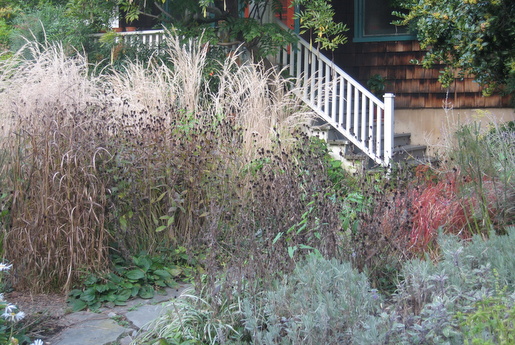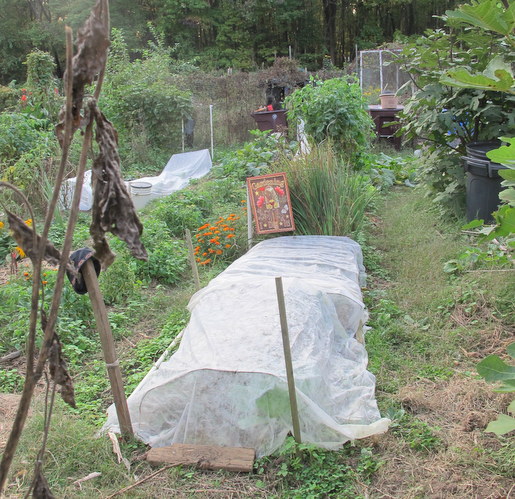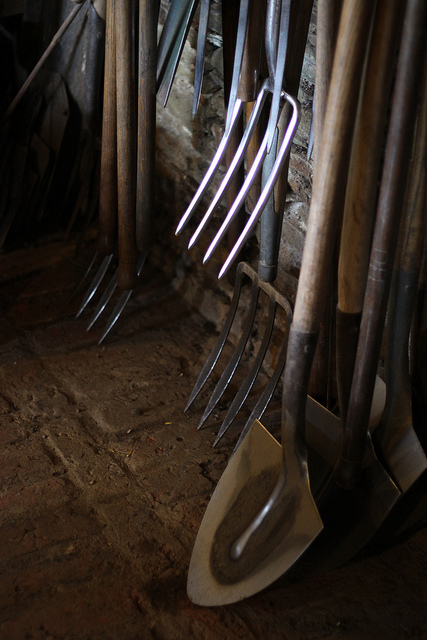How to Put your Garden Away for the Winter
Tips from horticulturist Carol Allen:
Vegetable Garden
- Remove and deeply compost debris all spent vegetable matter, except for anything that’s badly diseased, which should be removed but not composted. Before putting old plants in the compost Carol chops it all up with a machete on an old stump – that way it decomposes much faster.
- Remove and deeply compost any weeds. “Deeply compost” means putting the material it where it’s hot, inside the bin or pile. It’s important to remove weeds now because insect pests will use them as cover to overwinter.
- Plant fall/winter crops, or allow to stay in the garden these cool-weather crops: Swiss chard, carrots, radishes, kale and collards. They should be mulched, and to extend the season you can create a pseudo-cold frame by mounding straw alongside the rows. …or use dry leaves to form a protective mulch around them.
- Plant cover crops, especially in spots where you’ve grown such nitrogen-depleting crops as tomatoes and corn. Carol grows Austrian Winter Peas as cover crop because it’s a legume, so produces its own nitrogen. The tips taste like English peas. Yum! Cover crops protect the soil from winter wind and rain and after being turned into the soil in March (as a “green manure”) they put nutrients into the soil, becoming the fertilizer for your late spring and early summer crops.
- Prepare the spot for your early spring crops, like peas, by adding whatever amendments it needs and turning the soil. This preparation NOW is important so that in March when the soil is wet and hard to turn without creating compaction, your garden will be ready for planting. So amend, turn and mulch now because in March it’ll be too late.
- Prepare straw bale cold frames or other cover for crops that will winter over. As above: Swiss chard, kale, collards, carrots, parsley, etc.
- As a general method of productive vegetable gardening, Carol recommends lots of successional crops, and crop rotation to break the pathogen cycle. If you don’t have enough space in the ground to move the crops, you can use a container for them. Tomatoes, especially the patio or smaller types, grow just fine in pots.

Perennial Beds
- Cut down perennials as they die down (when they’ve become yellow and dry. For Carol this is a gradual process of removing things as they’re spent, but generally it’s all done by about January 1 in her garden. Great ones to leave up as long as possible include Amsonia hubrichtii for its bright orange yellow fall foliage, and any perennial parts that remain green. For some perennials that pop up late in the spring, like Butterfly weed, leave a marker or leave the stalks to mark the spot. For some perennials like purple coneflower or black-eyed-susans, Carol likes to leave 4″ stalks standing to protect the crown during winter.
- Gardeners who choose to leave all their dead perennial material standing through the winter for wildlife can just cut it all down in March. Many of them will then self-seed around the garden, which may be a welcome or unwelcome event, depending on the plant and how full the garden is.
- Remove spent annuals and deeply compost them.
- Remove and deeply compost weeds, too.
- Mulch after leaves have all fallen and been removed. Carol generally mulches in December. Mulching before the leaves are removed means disrupting the mulch in the leaf-removal process, so it’s easiest to wait a few weeks until that’s done.
- Divisions? Most perennials should be divided in spring, and a few in the summer (like iris). Now’s not the best time but could be done if necessary. Tough-as-nails plants like daylilies and hostas seem to handle some fall or winter disruption just fine.
- Get those bulbs planted!
Trees and Shrubs
- Prune clean any storm damaged branches so they can start to heal.
- All other pruning should be done by July 4th! Late summer or early fall pruning can trigger late growth that will not have time to harden off before winter. If it’s a spring bloomer, you have cut off flowers! Winter pruning is O.K. for some, if you need to and is a good time for corrective pruning on fruit trees. ….but best for blooming material is right after bloom. Maples and cherries, prune in summer as winter-spring pruning the tree will bleed.
- Mulch after leaf fall and removal, never piling mulch up against the bark of trees or shrubs above the root flare.
- Don’t feed now. Plants should be fed when they’re actively growing, not now when they’re going into dormancy. (What IS growing now? Lawn. See below.) So hold off on the Hollytone until March when new growth has started. This goes for vegetables too – best to feed the beds when new growth has started in the spring.
- Asked about shrub roses, like Knockout and others, Carol suggests pruning them as needed throughout the season, after each flush of flowers, but to do the major pruning in February or March after the new growth has started to appear.
Lawn
- Keep falling leaves off of newly planted grass.
- Fertilization season is now over. It needed to be done by Halloween.
- If your lawn has lots of broadleaf weeds, apply a pre-emergent broadleaf weedkiller in October-November.
- Mow lawn to a winter height of 3 to 3.5 inches.
- Clean and sharpen tools, paint handles, etc. (Carol paints her tool handles vibrant yellow so she can find them when dropped in the garden.)
- Secure pesticides and other liquids in a frost-free area. NOT in the tool shed.
- Keep dry products in moisture-free area, and that includes unused fertilizer.
- Secure row covers, frost blankets, and similar items in mouse-proof containers. That includes potting soil, where Carol has been known to find nests of mice, with babies.
- Inventory items that were in short supply, like stakes and gro-rings.
- Go over your notes and add any information that will help you make a better garden next year!
Posted by Susan Harris. Photo credits: Susan Harris, except for the photo of Tools.



yours looks sooooo organized and ready…….. question: I raised a plant from “a twig” called Firecracker or russalia something…… is this a must come in the house? More or less, all what is blooming in a pot or hanger – get it away from cold and frost> I gave up saving geraniums thru the winter… way too much work, it’s easier to wait for Behnke’s spring sale……….
Danke,
Christine
Yes, the Firecracker is a tropical plant, it needs to come indoors and should be in the sunniest window you can provide. They are great plants if you can coax it through the winter!
Larry Hurley